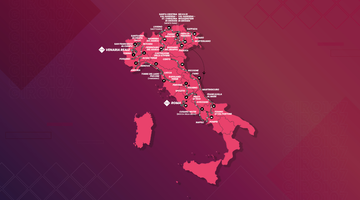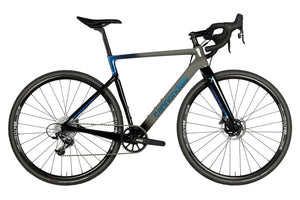Gravel: Complete Guide for Beginners
In this Article
Posted on August 23, 2021
Today Team The Cyclist House tells you about Gravel bicycles! In this article you will find all the information about this type of bike, its different equipment, how to use it and some tips. Nevertheless, if you always have questions after reading this article, do not hesitate to ask them on our Instagram or Facebook page: @Thecyclisthouse. We will be happy to answer you !

Believe us, the feeling of freedom and adventure that gives the bitumen behind you and to hear the screech of gravel under the wheels will suffice you to fall in love with Gravel bikes. It is not surprising that this type of bike has become so popular.
It is true that when we are used to rolling on the road, the Gravel driving can seem much more complicated. That's why we decided to write this article so that you can find all the information they need to help you get worried.
Define your needs
The evolution of Gravel bikes has continued to progress for recent years. Like every type of bikes, new models appear every year, ever more efficient, ever faster and more comfortable. However, it is not necessary to get the latest model in vogue to enjoy the benefits of Gravel bicycles.
To find the bike that suits you, it is necessary above all to define your needs. On what type of land do you want to ride (most frequently)? What is your budget ? It is important to ask all these questions before proceeding to buy. Also, you can just as well enjoy rolling on gravel with a bike you already have.
For this, you need to find the widest possible tires and, especially, resistant to punctures. On the other hand, if you really appreciate this way of rolling and you want to put there more, it will then be better to invest in a real Gravel bike. This will considerably improve your experience.
What are the features & equipment specific to Gravel bicycles?
What kind of tires for Gravel bikes?
On Gravel bikes, the most important facilities are the tires! The larger wheels and tires are strongly recommended on a Gravel bike, they can significantly absorb shocks and bumps on very "damaged roads." They also allow a much better adhesion. But remember, whatever the width of your wheel or tire, the inflation pressure is essential for rolling on gravel. In general, it is preferable to reduce the tire pressure, it makes it possible to find the balance between ideal traction and comfort, avoiding shocks and punctures.
To find the pressure that suits you, just do some tests. Generally, one or two tenths of bar less can already make a considerable difference. At The Cyclist House, we advise you to use a tire pressure gauge, it will allow you to compare the different effects as you change the pressure of your tires. Warning, if you notice that the tire crashes against the rim on the bumps or rocks, or if it folds when riding in turns, or that your speed seems very slow, is that your pressure is too much low.
Advised tires for equipping your Gravel bike are so-called "tubeless" tires (to be understood: without air chamber). They are renowned for using very low pressure with much less risk of puncture and more sealing. Air chamber tires are now a norm for off-road cycling. But, no matter what type of tire you use, it is essential to understand their system in order to maintain your bike and avoid puncture. It would be a shame to meet at the edge of the road at the beginning of the exit to repair your tires ...
What kind of footwear and pedals choose for your Gravel bike?
MTB shoes and pedals are more than recommended. Indeed, when you go through bike, it is possible that you spend by places and paths where you will not be able to roll and you will have to go down and walk. It is therefore important to be equipped with the right way so as not to ask a question!
What solution to maintain your chain in place?
Gravel roads are often rocky and full of bumps and situations where the bike chains will be numerous. This is why many Gravel models have adopted chain retention technology, borrowed from mountain bikes, to make sure the chain remains in place. A rear derailleur with a clutch promotes the retention of the chain by ensuring a constant tension of the chain on the bumps. It also provides flexibility in speed changes on rugged or bumpy terrains.
But, if your chain ends up falling while you ride and you can not reposition it by changing the derailleur, we advise you to put it manually at the stop. If you do not have a rear derailleur with clutch, The Cycliste House advises you to pay attention during your speed changes.
In the last point, the one to which a lot of cyclists does not think, the bottle holder! It is better, if you ride on rocky and bumpy roads, choose a safe bottles. Prefer materials such as steel, alloy or titanium, which can be adjusted and folded to keep your bottles safe.
What material use in case of puncture?
Gravel is generally done on roads less frequented and often far from cities. It is therefore essential to be autonomous in case of punctures. At The Cyclist House, we advise you to use saddle, handlebars, or frame bags. Inside, you can put your food, your tools, your spare parts and other clothes. We advocate for at least one hand pump, tire caps, fast links (for the chain), air chambers, a multiple tool with a chain breaker. And above all, do not forget a survival kit equipped according to the distance you are going to browse.
Our tips for practicing Gravel bike
Gravel roads are often rocky and lots of bumps, which is why they are hard to apprehend for our body. The secret is to be relaxed but with a firm grip, to absorb the bumps smoothly.
Choosing the trajectories
Unlike the practice of road bike, the Gravel bike requires more attention. You have to be able to analyze the field and look for areas where traction could be compromised. You will be able to better read the roads as and when your experience. Avoid too big or pointed rocks, deep holes and debris clusters that can cause the puncture of a tire. Deep sand plates or gravel in a turn can also be advertisers of problems. The good trajectories are smoother and free from rocks, which will give you more comfort and traction. Often, it is better to opt for the widest and sweetest turn, but the surfaces of the terrain can sometimes make it impossible. Try to ride where the road is smoother and harder. But if you end up in sand, mud or snow, try keeping the right bike and direct it in a straight line. Turn strong on soft surfaces will deprive you of your momentum and will make you fall.
GOODApprehendTurns and descents
We know that turns and descents can scare! Start by lowering your center of gravity. Keep your chest low and drop your heels. Fear and instinct often grow new cyclists to recover and get away from the danger perceived. But that imbalances the front tire, which reduces traction and often increases the probability of a fall.
In turns and descents, put yourself in dancer to bring the bike weight by the pedals rather than by the saddle. This will give you more control by focusing your weight on the pedal.
Do not look right in front of you and try to look far in front of you in the turn to the exit. Lean the bike under you in turns. The bike turns by trimming and the tilt separately from your body applies more weight on the tire contact surface, which gives you more traction and control. If possible, lower and add your outer foot / pedal to lower your center of gravity and produce more traction.
Some tips for brake
Regarding braking, we advise you to tighten the brakes smoothly, it will save you from blocking them. A tire that slip has much less traction than a rolling tire. The front brake gives you a greater braking power, it must be used carefully and be modulated with the rear brake.
Your brakes are generally better used when the bike is straight and rolled in a straight line. That's when the tires have the most adhesion. To apprehend a turn, it is better to curb completely before it and then turn without curing. This will avoid good numbers of slippages! This is particularly important if the turn is loose, rough or bumpy.

Latest Tips!
Our latest tips are: Try, explore and have fun!
The best in the Gravel is the sense of adventure that driving on more accident routes. Gravel bikes are incredibly efficient and allow you to explore new roads and new paths. Go gradually, trust and you will only improve yourself. Give yourself challenges, get out of your comfort zone. Find friends or groups with whom you can go to adventure. Do not be shy with what you are trying on a Gravel bike. A track that could be boring and easy on a mountain bike could become your favorite track on a Gravel Bike. Start slowly and increase the distance until you make hikes one night! Take a lot of food and water and go.
Unlike most other cycling disciplines, events or races are one of the best ways for a beginner to dive into the Gravel. The races are fun and generally very well organized. If there is one in your area, it will probably discover an entirely new itinerary that you would never have discovered.
Gravel races are becoming more and more popular, and new races are constantly emerging. The front of the race is generally competitive. But if you are not at the front of the race, the majority of riders are more concerned about finishing the course and have a good time by doing so. This makes Gravel events and races one of the best ways to enjoy it and learn a brand new driving style.
TO KNOW !
When it comes to tires, the bigger they are, the better. Spend tires from 38 mm to 45 mm and your confidence will become demultiplage!
The Strava app is really top! Do not let anyone tell you the opposite. Of course, you do not need to watch a screen all the time. But let the app operate and look at your course after the way. Share your course with others. Bring the good mood! Look for the different connectors and the secondary trails you can explore.
Do not abuse turns. If you ride with slick tires of 30 mm, be careful by leaning on the wave terrain. Staying straight is more important than going faster in a turn.
Flareable falling guides are the best! The lower part of the bar is evasible. This wide position gives you a lot more control when riding on tracks and technical descents.
Stay positive! It is possible that at a given moment, during a Gravel route, you will have the impression of not having the right equipment because the ground is very varied. It does not matter, you are exploring on a bike, so have fun and enjoy it maximum.
Do not ask too many questions! A thirst for adventure is everything you need to get started. Once you have a better understanding of what you want to do, you can buy the necessary equipment. If you do not know it already, do not wear underwear under your bike shorts. Never.



























